
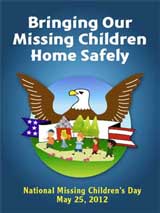
2012 Missing Children's Day poster.
Speakers at the event included Deputy Attorney General James M. Cole, Acting Assistant Attorney General for the Office of Justice Programs Mary Lou Leary, OJJDP Acting Administrator Melodee Hanes, President and CEO of the National Center for Missing & Exploited Children Ernie Allen, and Yvonne Pointer, a child and community safety activist whose 14-year-old daughter, Gloria, was abducted and killed in 1984.
In 1983, President Reagan proclaimed May 25 as National Missing Children's Day in honor of 6-year-old Etan Patz, who disappeared in 1979 during a two-block walk to his school bus stop in lower Manhattan. Since then, citizens, public agencies, and private organizations have gathered in communities across the country to commemorate the day by renewing their commitment to find missing children and celebrate stories of recovery.
"There is no rest for a parent who has lost a child, and there should be no rest for any of us who are in a position to help," said Deputy Attorney General Cole. "There may not be any words we could offer that would ease their pain, but we can offer our support—and we must use all the tools at our disposal to help families of missing and exploited children."
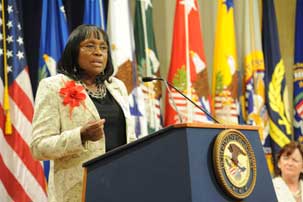
Yvonne Pointer, a child and community safety activist whose 14-year-old daughter, Gloria, was abducted and killed in 1984, offered remarks at the National Missing Children's Day ceremony. "Service to others saved my life, providing me with a reason to live," she said.
Deputy Attorney General Cole presented awards to the following individuals for their extraordinary efforts to help abducted and/or exploited children:
- Attorney General's Special Commendation: Special Agent Tim Erickson, North Dakota Bureau of Criminal Investigation
- Missing Children's Law Enforcement Award: Detective Randall Abbott, Hartford (WI) Police Department
- Missing Children's Citizen Award: Letter Carrier H. Keith Ray, U.S. Postal Service, St. Louis, MO
- Missing Children's Child Protection Award: Assistant State Attorney Gregory Schiller (FL)
At the ceremony, Acting Administrator Hanes announced
the release of three new OJJDP publications—
- AMBER Alert Best Practices describes effective and efficient strategies for recovering abducted children, based on information from experienced AMBER Alert partners in law enforcement, the broadcast and wireless industry, transportation agencies, and the community.
- ¿Y yo? Cómo sobrellevar el secuestro de un hermano o una hermana, the Spanish translation of What About Me? Coping With the Abduction of a Brother or Sister, contains information to help and support a child when his or her sibling is kidnapped. It also includes activity pages for children of all ages, including those who are too young to read.
- No estás solo: El camino del secuestro al empoderamiento, the Spanish translation of You're Not Alone: The Journey From Abduction to Empowerment, presents several stories of child abduction survivors and how they have grown and developed from their traumatic experiences. It provides information to help other child abduction survivors cope with their own experiences and begin their journeys toward a better future.
For more information about these publications, see the New Publications section in this issue of OJJDP News @ a Glance.
Each year, OJJDP conducts a National Missing Children's Day poster contest. The winning poster is used as the design theme for the following year. This year, 5th graders in 41 states and the District of Columbia participated in the competition. Elisa Martinez, a student at Walter V. Long Elementary School, Las Vegas, NV, accepted the 2012 National Missing Children's Day Art Contest Award.
Vocalist Darren Jones sang the national anthem. The event began and concluded with performances by the Benjamin Orr Elementary School Choir of Washington, DC. The Office of Justice Programs has had a relationship with the Orr School since 1991 as part of the Justice Department's volunteer outreach program.

Acting Administrator Melodee Hanes announced the release of OJJDP's three new child abduction resource publications on National Missing Children's Day.
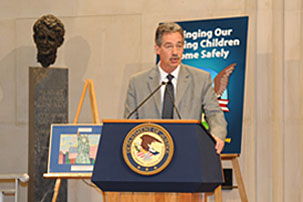
Deputy Attorney General James M. Cole offering a keynote address at the National Missing Children's Day ceremony. "It is a real privilege to be here today, in the presence of so many advocates and law enforcement professionals who work—day in and day out—to secure the safety of one of our most vulnerable populations, our young people," Cole said.
Resources:
To access additional resources for parents of missing and abducted children, go to the OJJDP Web site. Also visit the National Center for Missing & Exploited Children's "Take 25" Web site, which encourages parents, guardians, educators, and other caring adults to take 25 minutes to talk to children about safety. Information about the Office of Justice Programs' AMBER Alert Program is also available online.
In recognition of National Missing Children's Day, the Office of Justice Programs' National Criminal Justice Reference Service has created a special feature, Missing Kids, which provides critical AMBER Alert information as well as access to resources for families and law enforcement.
A blog about National Missing Children's Day by Acting Assistant Attorney General Mary Lou Leary is available on the U.S. Department of Justice Web site.
To Keep Children In School and Out of the Justice System

On July 21, 2011, Attorney General Eric Holder and Secretary of Education Arne Duncan announced the creation of the Supportive School Discipline Initiative (SSDI). The initiative is a collaboration between the two agencies to target harsh and exclusionary school disciplinary policies and in-school arrests that push youth out of school and into the justice system, a process also known as the school-to-prison pipeline.
The announcement of the new initiative came 2 days after the Council of State Governments (CSG) Justice Center released findings of a study on the impact of school disciplinary practices on students' academic success and juvenile justice involvement.
Among other findings, the study determined that only 3 percent of disciplinary actions were for conduct for which state law mandates suspensions and expulsions; the rest of the disciplinary actions were made at the discretion of school officials, primarily in response to violations of local schools' conduct codes. In addition, minority youth and children with disabilities were disciplined more harshly for similar or less serious infractions than were their peers. The researchers also found that when a student was suspended or expelled, his or her likelihood of being involved in the juvenile justice system the subsequent year increased significantly.
"OJJDP does research to support best practices, and one of the things we've learned is that the minute a youth sets foot in detention or confinement, their prospects for success and having a job decrease dramatically and the likelihood that they will end up in the adult criminal system increases exponentially," said OJJDP Acting Administrator Melodee Hanes in a recent interview. "That's why SSDI is one of our top priorities."
The response to the CSG findings from national media outlets has been strong. The New York Times, National Public Radio, and The Washington Post have all featured followup stories about the report, underscoring the urgent need to begin a national dialog to address school discipline policies and practices. In addition, numerous philanthropic organizations with a focus on school discipline have reached out to the U.S. Departments of Education (ED) and Justice (DOJ) to see how they might assist in addressing the issue.
Since the initiative was announced in July 2011, significant progress has been made. Within a month of launching the initiative, DOJ and ED had organized a Justice-Education workgroup, led by OJJDP and ED staff. More than 30 federal staff are currently participating in 4 sets of activities:
- Developing a national consensus on policies and best practices for addressing counterproductive school discipline practices.
- Coordinating research and data collection efforts.
- Issuing guidance documents to help states and localities address school discipline more effectively.
- Developing training and resources to help schools and school-related stakeholders (e.g., school-based law enforcement, courts, and probation) adopt more positive strategies and ensure compliance with civil rights laws.
On March 11–13, 2012, the New York State Permanent Judicial Commission on Justice for Children held the first-ever National Leadership Summit on School-Justice Partnerships. The summit, which took place in New York City, brought together juvenile court judges, school administrators, juvenile justice professionals, educators, and researchers from nearly every state and territory to focus attention on the importance of school-justice partnerships and evidence-based strategies that can help students stay in school and out of the juvenile justice system.
OJJDP Acting Administrator Hanes and Education Assistant Secretary for Civil Rights Russlynn Ali offered keynote remarks. "The challenges we face are too big, too many, and too complex for any one of us to tackle alone," Acting Administrator Hanes said. "That is why we continue to pursue partnerships among our colleagues in the federal government, and to work closely with states, localities, and the nonprofit and philanthropic communities." Hanes also joined fellow panelists in an Education Funders Strategy Group session to provide information about the goals and expected outcomes of SSDI and attended meetings at the summit.
SSDI workgroup members provided the summit teams with state-specific packets of base-level data to help attendees begin planning.
The CSG Justice Center's report also demonstrates that the use of suspension and expulsion varies greatly among schools, even among schools with similar student populations and identical discipline policies, a discrepancy that indicates a high level of individual discretion in school administrators' application of discipline policies. In addition, prosecutors, defense attorneys, and professionals in law enforcement, the courts, and probation often have varying perspectives on school discipline.
With funding from OJJDP, Atlantic Philanthropies, and the California Endowment, CSG Justice Center staff are managing a process that includes focus group discussions to build consensus on school discipline and address a range of topics, including law enforcement and school safety, methods for measuring school safety, child and adolescent health, and juvenile courts.
Focus group members represent a broad range of stakeholders—law enforcement professionals; community members; education practitioners; representatives from federal agencies; private foundation executives; child, adolescent, and school-based health experts; court officials; and juvenile justice practitioners. During the next 12–18 months, advisory groups composed of selected focus group members will prepare a report with recommendations for improving school discipline policies and practices. The report will be provided to state and federal legislators, policymakers, and national organizations such as the National Conference of State Legislators, the Council of Chief State School Officers, and the National Governors' Association.
This spring, a listening session in Washington, DC, and two Webinars were held to identify resources, tools, and training products that will fill knowledge gaps and promote effective school discipline without resorting inappropriately to suspension, expulsion, or arrest. These sessions are laying the groundwork for the development of a toolkit for schools and other stakeholders to use as they address discipline issues.
Resources:
The CSG Justice Center's report, Breaking Schools' Rules: A Statewide Study on How School Discipline Relates to Students' Success and Juvenile Justice Involvement, is available on the center's Web site. Presentations from the 8 plenaries and 12 breakout sessions at the National Leadership Summit on School-Justice Partnerships are also available online.
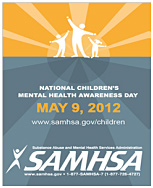
On May 9, 2012, Attorney General Eric Holder, together with Melodee Hanes, Acting Administrator of OJJDP, joined the U.S. Department of Health and Human Services' Substance Abuse and Mental Health Services Administration (SAMHSA) in providing remarks at an event observing National Children's Mental Health Awareness Day. The theme of this year's public awareness effort was promoting recovery and resilience for youth in the juvenile justice and child welfare systems. The event, held in Washington, DC, paid tribute to youth who have demonstrated resilience after traumatic experiences, as well as the Heroes of Hope who helped enhance their resilience.
In his remarks, Attorney General Holder cited statistics from an OJJDP-supported study showing that more than 60 percent of American youth were exposed to violence, crime, and abuse during a 1-year period.
"As Attorney General—and as the father of three teenagers—protecting the safety, and the potential, of our nation's young people has long been both a personal and professional priority," said Holder. "From the landmark Defending Childhood initiative—which we launched in 2010—to the National Forum on Youth Violence Prevention . . . I'm proud to report that today's Department of Justice is partnering with state officials, local leaders, and stakeholders at every level to develop and implement tailored strategies for combating . . . violence."
Acting Administrator Hanes stressed that youth in the child welfare and juvenile justice systems have often experienced trauma, abuse, and violence in their homes and communities. "We must do the right thing for these young people; we need to properly assess their problems, offer them the treatment and care they need, and intervene in the conditions that brought them to the system," she said.
Leon Harris of ABC7/WJLA–TV hosted the program. Kathleen Sebelius, Secretary of the U.S. Department of Health and Human Services, presented a Special Recognition Award to artist and Awareness Day National Event Honorary Chairperson Cyndi Lauper.
The program complemented activities taking place across the country, such as youth rallies, social media campaigns, and activities with children that promote community conversations about the importance of caring adults in enhancing resilience in youth following traumatic experiences.
OJJDP and more than 130 organizations collaborated with SAMHSA on Awareness Day this year.
Resources:
More information about the National Children's Mental Health Awareness Day event and resources on childhood trauma and mental health may be accessed on the SAMHSA Web site. A transcript of the Attorney General's speech is available on the U.S. Department of Justice Web site.
Children in the juvenile justice system are often removed from their homes and schools to facilities outside their community and, as a result, they are separated from caring adults who know them well. These adults, who may include a biological parent, a grandparent, an aunt, coach, or other mentor, are important to a child's rehabilitation, recovery, and healing. In many cases, they will also be the primary source of support once youth reenter their communities. Regular input from a youth's family—whether biological or "chosen"—is key to successful outcomes for youth at all points in the juvenile justice spectrum. Yet, too often, families are kept at the margins, whether in the courts, in the development of a case plan, or in reentry services.
In July 2011, the Coordinating Council on Juvenile Justice and Delinquency Prevention identified family engagement as a major item for consideration and action. Administered by OJJDP, the council brings together senior officials from the U.S. Departments of Justice (DOJ), Education (ED), Health and Human Services (HHS), Labor (DOL), Housing and Urban Development (HUD), and other federal agencies to share information and resources, and to work toward the enhancement and reform of policies and practices on a range of critical issues facing at-risk children as well as youth involved in the justice system.
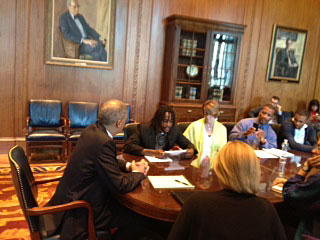
On May 11, 2012, families of currently or previously incarcerated youth met with Attorney General Eric Holder to offer recommendations for improving the juvenile justice system.
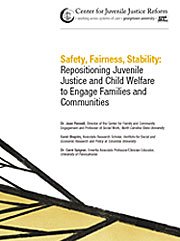 The council meeting also included reports from members of a federal workgroup on recent activities to elevate family engagement as a priority within their respective agencies and to recommend ways that family engagement and partnerships can be advanced at the federal level.
The council meeting also included reports from members of a federal workgroup on recent activities to elevate family engagement as a priority within their respective agencies and to recommend ways that family engagement and partnerships can be advanced at the federal level.
The workgroup is composed of staff from OJJDP, HHS, and ED; over the past 18 months, it has shared ideas and strategies and collaborated with Georgetown University's Center for Juvenile Justice Reform (CJJR). A CJJR monograph, Safety, Fairness, Stability: Repositioning Juvenile Justice and Child Welfare to Engage Families and Communities, released in May 2011, outlines a vision for fostering the interpersonal connections of youth and families so that significant relationships are maintained or restored. In November 2011, CJJR released a set of detailed recommendations to federal agencies that were developed with workgroup members and other stakeholders. The recommendations cover a range of topics, including creating and embedding family-focused policies and practices in the work of federal agencies, building infrastructure to formally include families in the development and implementation of policies and practices, and supporting families to become more effective advocates.
—Shay Bilchik, Director,
Center for Juvenile Justice Reform
Workgroup representatives providing reports were Melodee Hanes, OJJDP's Acting Administrator and vice-chair of the council; David Esquith, Acting Director of ED's Office of Safe and Healthy Students; Larke Huang, Senior Advisor on Children at HHS's Substance Abuse and Mental Health Services Administration; Martha Moorehouse, Director of the Children and Youth Policy Division in HHS's Office of the Assistant Secretary for Planning and Evaluation; and Joe Bock, Acting Associate Commissioner of HHS's Children's Bureau.
Hanes reported that OJJDP activities and accomplishments include:
- Grants to organizations that provide parent-to-parent support and mentoring for families learning to navigate the juvenile justice system.
- OJJDP requirements that grantees include youth and family members on their governing or advisory boards and their planning collaboratives.
- Listening sessions in the spring and summer of 2011 with youth and family members from across the country.
- Inclusion of youth and family representatives in trainings and conferences, notably OJJDP's National Conference for Children's Justice and Safety in October 2011 and DOJ's annual tribal youth summits.
- OJJDP's launch in late 2011 of the National Center for Youth in Custody. The center embraces youth, family, and community engagement in its support of youth facilities and has placed family and youth representatives on its advisory body.
- The incorporation of family and youth perspectives in several DOJ signature initiatives, such as Defending Childhood, the Supportive School Discipline Initiative, and the National Forum on Youth Violence Prevention.
- The recent establishment of an OJJDP staff working group to develop and coordinate activities related to youth and family engagement across OJJDP.
- OJJDP staff training on family and youth engagement.
Hanes also summarized action items agreed to be undertaken jointly by the DOJ-HHS-ED workgroup:
- Disseminating and discussing recommendations from the CJJR report.
- Developing a proposal for a parent-youth committee on the council.
- Improving coordination among the participating agencies on existing activities and sharing and mentoring one another on successful strategies.
- Targeting initial work in the area of family engagement to youth in juvenile justice residential facilities and their families because the issues affecting justice system-involved youth also touch nearly all systems represented by the council, including child welfare, mental health, education, labor, and housing.
"We need to disabuse ourselves of the notion that when children come into our systems we can and should separate them from their families," said CJJR Director Shay Bilchik at the council meeting. "We need to think about how to help youth navigate those families—to build on the families' strengths, and help overcome the weaknesses. We do our best work if families are at our core, not on the periphery."
Resources:
CJJR's report, Safety, Fairness, Stability: Repositioning Juvenile Justice and Child Welfare to Engage Families and Communities, is available on the center's Web site. For more information about the listening sessions on family engagement hosted by OJJDP, read the July/August 2011 issue of OJJDP News @ a Glance.
 Grantees from eight demonstration sites in the Attorney General's Defending Childhood initiative gathered in Washington, DC, on May 15–17, 2012, for a series of presentations, peer-to-peer exchanges, and dialog with Justice Department leadership. The grantees are preparing to implement comprehensive, community-based strategies to address children's exposure to violence.
Grantees from eight demonstration sites in the Attorney General's Defending Childhood initiative gathered in Washington, DC, on May 15–17, 2012, for a series of presentations, peer-to-peer exchanges, and dialog with Justice Department leadership. The grantees are preparing to implement comprehensive, community-based strategies to address children's exposure to violence.
Mary Lou Leary, Acting Assistant Attorney General, Office of Justice Programs; Melodee Hanes, Acting Administrator, OJJDP; Bea Hanson, Acting Director, Office on Violence Against Women; and Catherine Pierce, Associate Administrator, Child Protection Division, OJJDP, provided opening remarks.
"Children's exposure to violence is a complicated, multifaceted problem that requires a sophisticated and targeted approach,” said Acting Assistant Attorney General Leary. "Each of you brings ideas and experiences to the table that can be useful to others as they brainstorm solutions. Our goal here is to facilitate the exchange of ideas and help you tap into your strengths."
—Participant, Defending Childhood All-Sites Meeting
Organized by OJJDP's Child Protection Division and Futures Without Violence, the grantees' meeting featured presentations and workshop sessions on a range of topics, including fostering collaboration among child-serving agencies, working with youth and families involved in both the child welfare and juvenile justice systems, the vital role of judges in addressing children's exposure to violence, trauma-informed care, community organizing, the uses of data, positive messaging for social change, working with immigrant and refugee communities, and the need for culturally sensitive programs and services.
Defending Childhood's eight demonstration sites are the city of Boston, MA; the city of Portland, ME; the Chippewa Cree Tribe, MT; the city of Grand Forks, ND; the Cuyahoga County Board of Commissioners, OH; the Multnomah County Department of Human Services, OR; the Rosebud Sioux Tribe, SD; and Shelby County, TN.
Attorney General Eric Holder launched Defending Childhood in September 2010 to prevent, address, reduce, and more fully understand childhood exposure to violence.
According to the OJJDP-sponsored 2008 National Survey of Children's Exposure to Violence, nearly one-half of children and adolescents were assaulted at least once in the past year, and more than 1 in 10 were injured in an assault. More than 60 percent of the children surveyed were exposed to violence, crime, and abuse during the same period, either as victims or witnesses.
National Council of Juvenile and Family Court Judges' 75th Annual Conference:
July 15–18, 2012

This conference, to be held in New Orleans, LA, will focus on a range of juvenile and family law topics, including child abuse and neglect, trauma, custody and visitation, high-conflict divorce, juvenile justice, domestic violence, and substance abuse. The annual event provides information and tools to juvenile and family courts to support their efforts to improve case processing and outcomes for children, youth, families, victims, and communities. For more information and to register, visit the conference Web site.
Fifth National Conference on Behavioral Health for Women and Girls: July 17–19, 2012
This conference, which will take place in San Diego, CA, will bring together professionals working in prevention, mental health, and addiction services for women and girls. Sponsored by the Substance Abuse and Mental Health Services Administration in partnership with Mental Health Systems, Inc., "It's All About HERR—Health, Empowerment, Resilience, and Recovery" will emphasize gender-responsive, culturally competent, and trauma-informed principles and practices. For information and to register, visit the conference Web site.
Children's Defense Fund National Conference: July 22–25, 2012
The conference will present the latest research findings, best practices, community-building models, and empowerment strategies to meet the needs of children and the poor, including a focus on diminishing child and youth involvement in the juvenile justice system. The conference will take place in Cincinnati, OH. Registration is available online.
2012 Prevention of Youth Substance Abuse in Rural Communities Conference: August 1–3, 2012
Sponsored by the Coalition for Healthy Youth, this training conference emphasizes the unique challenges of preventing youth substance abuse in rural communities. The conference theme is "Reaching Out to the Missing Partners." Visit the conference Web site for more information.
11th National Conference on Addiction and Criminal Behavior: August 12–15, 2012
Designed for addiction and criminal justice professionals, the conference will address the challenges of reentry and the relationship between addiction and criminal behavior. Sessions will cover a range of topics, including key elements to reentry planning, current drug trends, the psychology of addiction, effective program development, gangs in the 21st century, strength-based intervention for juveniles, co-occurring disorders, juvenile-specific treatment issues, working within a correctional setting, transitioning juvenile offenders back into society, and suicide prevention. The conference will take place in St. Louis, MO.
24th Annual Crimes Against Children Conference: August 13–16, 2012
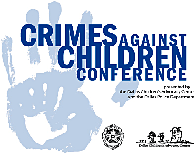 Sponsored by the Dallas Children's Advocacy Center and the Dallas Police Department, this conference is designed to meet the training needs of professionals from the fields of law enforcement, prosecution, child protective services, social work, children's advocacy, therapy, and medicine who work directly with child victims of crime. The conference, to be held in Dallas, TX, will provide training in the detection, investigation, prosecution, and healing interventions in all types of child victimization, including physical and sexual abuse, neglect, fatalities, sexual exploitation, abduction, trafficking, and Internet-related exploitation. To register, go to the conference Web site.
Sponsored by the Dallas Children's Advocacy Center and the Dallas Police Department, this conference is designed to meet the training needs of professionals from the fields of law enforcement, prosecution, child protective services, social work, children's advocacy, therapy, and medicine who work directly with child victims of crime. The conference, to be held in Dallas, TX, will provide training in the detection, investigation, prosecution, and healing interventions in all types of child victimization, including physical and sexual abuse, neglect, fatalities, sexual exploitation, abduction, trafficking, and Internet-related exploitation. To register, go to the conference Web site.
13th National Conference on Child Sexual Abuse and Exploitation Prevention:
August 28–30, 2012
This conference will take place in New Orleans, LA. Sponsored by the National Children's Advocacy Center, the conference will include presentations by nationally renowned experts on current research and trends in preventing child sexual abuse and commercial exploitation. Registration is available online.
2012 National Center for Victims of Crime Conference: September 19–21, 2012
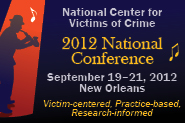
Experts will lead nearly 80 information and skill-building sessions at this conference, cohosted by the Louisiana Foundation Against Sexual Assault and the Louisiana Coalition Against Domestic Violence. Session topics include Assessing and Addressing Domestic Minor Sex Trafficking in a Local Context, Child Protection in Youth-Serving Organizations, Secondary and Vicarious Trauma: An Interactive Approach to Caring for Service Providers, Responding to Foreign Child Victims of Human Trafficking, Incorporating Victim Voices Into Research: Examples From the Field, and Promising Partnership Practices Between Law Enforcement and Immigration Victims of Crime. Registration for the event, which will be held in New Orleans, LA, is available online.
119th Annual International Association of Chiefs of Police Conference and Expo:
September 29–October 3, 2012
To be held in San Diego, CA, this annual conference, organized by the International Association of Chiefs of Police, brings together police leadership from around the world to discuss current trends and challenges in law enforcement and to share lessons learned in more than 200 educational sessions. Topics from past conferences have included strategies for leading change in police culture, online learning and operational support, public law enforcement and private security collaboration, violent crime, use-of-force issues, training, and case studies. More than 800 companies will showcase their products at the conference, which constitutes the largest venue in the world for exhibiting technology designed specifically for law enforcement. To register for this event, go to the conference's Web site.
DOJ Releases Final PREA Rule for Adult and Juvenile Facilities
On May 17, 2012, the U.S. Department of Justice released a final rule to prevent, detect, and respond to sexual abuse in confinement facilities, in accordance with the Prison Rape Elimination Act (PREA) of 2003. The final rule sets national standards protecting inmates in adult prisons and jails, lockups, community confinement facilities, and juvenile facilities at the federal, state, and local levels. An executive summary is available on the Office of Justice Programs Web site. To learn more about the Act, and to access PREA-related resources, including training and technical assistance, visit the National PREA Resource Center.
 OJJDP and COPS Office Host Meeting on Law Enforcement Response to Children's Exposure to Violence
OJJDP and COPS Office Host Meeting on Law Enforcement Response to Children's Exposure to Violence
As part of the U.S. Department of Justice's (DOJ's) Defending Childhood initiative, OJJDP and DOJ's Community Oriented Policing Services (COPS) Office held a meeting of national experts in law enforcement and other key stakeholders who come into contact with children exposed to violence. The goal of the meeting, which was held in Washington, DC, on May 21–22, 2012, was to discuss strategies to better identify, prevent, and respond to children's exposure to violence. The meeting will help lay the groundwork for the creation of a toolkit for law enforcement and other agencies that serve children.
OJJDP-Supported Study Examines Evidence on the Effectiveness of Juvenile Court Sanctions
In the article "Evidence on the Effectiveness of Juvenile Court Sanctions" published in the November/December 2011 issue of the Journal of Criminal Justice, researchers present the findings of an OJJDP-supported study. The researchers found that few evaluations take into account the significant variations in sanctions and in the programming used to administer the sanctions. They argue that, despite substantial advances in evaluation research, this variability significantly restricts the generalizability of evaluation outcomes and it raises questions about whether enough is known about the effectiveness of many juvenile justice sanctions to consider them proven and effective practices. To read the abstract of the article, visit the Web site of the National Criminal Justice Reference Service.
Attorney General Eric Holder Convenes Third Federal Reentry Council Meeting
On May 10, 2012, Attorney General Eric Holder convened the third meeting of the Federal Interagency Reentry Council at the U.S. Department of Justice (DOJ). The council represents 20 federal agencies working to make communities safer by reducing recidivism and victimization, assisting those who return from prison and jail in becoming productive citizens, and saving taxpayer dollars by lowering the direct and collateral costs of incarceration. Among the topics discussed at the meeting were important new efforts to reduce barriers to employment. To access DOJ's press release about the meeting, visit the DOJ Web site.
DOJ Releases Tribal Youth Summit Videos
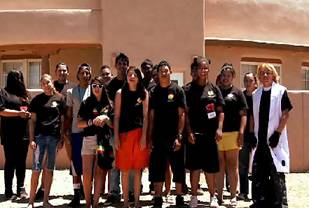
Still from "That's My People" PSA.
The U.S. Department of Justice (DOJ) has posted an 8-minute video highlighting its 2011 National Intertribal Youth Summit held last July in Santa Fe, NM. The "2011 National Tribal Youth Summit" video covers activities from the week-long event, attended by more than 160 youth representing nearly 50 tribes.
In addition, a public service announcement (PSA) video—"That's My People"—is available on the DOJ Web site. In the PSA, developed at the summit, tribal youth talk about issues that they have identified as important to address with their tribal leaders.
National Gang Center Launches Newsletter on Gang Reduction
The National Gang Center has released the inaugural issue of its quarterly newsletter. The issue features articles on the challenges to schools' anti-gang policies and gang activity amid the falling crime rate, among other topics. The newsletter aims to inform practitioners, researchers, law enforcement, and others with a shared interest in gangs about current trends, significant court decisions, trainings, and strategies being used in communities to address gangs. The center is supported by OJJDP and the Bureau of Justice Assistance.
Safe Start Center's Antibullying Blog Receives Award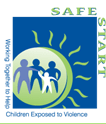
The Safe Start National Resource Center's National Bullying Prevention Month blog series has been honored as a 2011 AVA Gold Winner. The AVA awards are sponsored by the Association of Marketing and Communication Professionals and recognize outstanding achievement in concept, direction, design, and production of media. Funded by OJJDP, the Safe Start Center works to broaden the knowledge of and promote community investment in preventing and reducing the impact of children's exposure to violence.
OJJDP Updates Statistical Briefing Book
OJJDP has updated its Statistical Briefing Book (SBB) to include the latest data on FBI arrests and victims of domestic violence, a redesigned Compendium of National Juvenile Justice Datasets, and new Frequently Asked Questions on teen mothers, juvenile educational characteristics, child maltreatment victims, and school crime victimization.
SBB offers easy access to online information about juvenile crime and victimization and about youth involved in the juvenile justice system. Developed for OJJDP by the National Center for Juvenile Justice, the SBB provides timely and reliable answers to questions OJJDP most frequently receives from the media, policymakers, and the general public.
OJJDP Holds Webinars on Trends for Youth in Custody, Leadership Development
On June 13, 2012, OJJDP's National Center for Youth in Custody (NC4YC) presented the Webinar, "Is the Juvenile Justice Realignment Train Slowing Down?" After nearly two decades of falling crime, downsizing juvenile corrections and detention is a central theme in a growing number of juvenile justice systems. The Webinar discussed whether these trends indicate a permanent shift in policy and practice, or merely a temporary reaction to tight budgets and low rates of violent crime.
On May 9, 2012, NC4YC held a Webinar entitled "Leadership: Keys to Leading Juvenile Justice Reform." Presentations focused on collaborative leadership, leadership in culture change, and leadership in empowering youth and families in the rehabilitative process.
Material from the Webinars is archived and accessible on NC4YC's Web site.
Upcoming Webinars include Conditions of Confinement (September 12), Family Engagement (October 17), and Continuum of Services (November 14).
OJP Releases 2012 Program Plan
The Office of Justice Programs (OJP) recently posted its Program Plan for 2012, a searchable online document of current funding opportunities and new initiatives. The plan features information for each of the component offices within OJP regarding both competitive and noncompetitive grants, training and technical assistance, research, and other resources available to the justice community. Also, the plan provides a glossary of acronyms and definitions, answers to frequently asked questions, and an alphabetized index of the programs found in the plan.
 New Report Analyzes AMBER Alert Cases in 2011
New Report Analyzes AMBER Alert Cases in 2011
The National Center for Missing & Exploited Children's recently released 2011 AMBER Alert Report provides an analysis of AMBER Alert cases from January 1–December 31, 2011. During that period, a total of 158 AMBER Alerts, involving 197 children, were issued in the United States. Of the 158 alerts issued, 144 cases resulted in a recovery. Twenty-eight of the recoveries occurred as a direct result of AMBER Alerts.
Education Department Seeks Information on Disconnected Youth
The U.S. Department of Education has released a request for information (RFI) on Strategies for Improving Outcomes for Disconnected Youth. The RFI invites organizations to recommend effective approaches to increase the rate at which young people ages 14 to 24 who are homeless, in foster care, involved in the juvenile justice system, unemployed, or not enrolled in an educational institution meet educational, employment, and other key development goals. Submissions must be received by July 5, 2012. Submit responses to the RFI via regulations.gov.
 May Issue of NJJEC Bulletin Now Available
May Issue of NJJEC Bulletin Now Available
The National Juvenile Justice Evaluation Center (NJJEC), funded by OJJDP, has released the May 2012 issue of its newsletter, the NJJEC Bulletin. The bulletin features articles on how to better use “what works” databases for juvenile justice, collecting outcome data for prevention programs, activities at NJJEC, upcoming events, and a state spotlight on Georgia.
All OJJDP publications may be viewed and downloaded from the publications section of the OJJDP Web site. Print publications also may be ordered online at the National Criminal Justice Reference Service (NCJRS) Web site.
Publications Released at Missing Children's Day Commemoration (May 23, 2012)
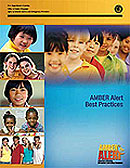
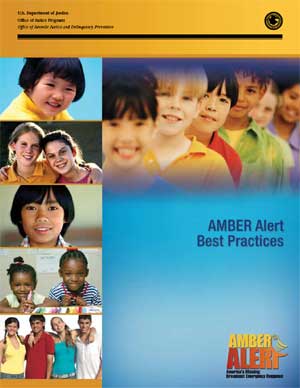 AMBER Alert Best Practices
AMBER Alert Best Practices
NCJ 232271
The AMBER Alert system, managed by the U.S. Department of Justice's Office of Justice Programs with the support of OJJDP, issues media alerts when a law enforcement agency determines that a child has been abducted and is in imminent danger. The goal of an AMBER Alert is to instantly galvanize the entire community to assist in the search for the missing child. This guide is a compilation of the most effective and efficient strategies for recovering abducted children. It is based on information from a range of AMBER Alert partners in law enforcement, the broadcast and wireless industry, transportation agencies, and the community.
To view and download this publication, or to order a printed copy, visit the NCJRS Web site.
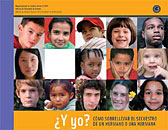
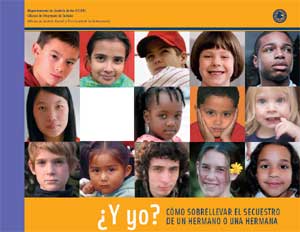 ¿Y yo? Cómo sobrellevar el secuestro de un hermano o una hermana
¿Y yo? Cómo sobrellevar el secuestro de un hermano o una hermana
NCJ 237775
This is the Spanish-language version of What About Me? Coping With the Abduction of a Brother or Sister. Each year, more than 58,000 children are abducted by a nonfamily member. Although this is an enormous number, it does not take into account other young victims—the sisters and brothers of those who have been abducted. These overlooked children suffer the loss of their sibling, and family patterns are irrevocably changed. Eight such siblings joined with the Justice Department to write this guide. The publication contains information to help and support children when their sibling is kidnapped. It includes activity pages for children of all ages, including those who are too young to read.
To view and download this publication, or to order a printed copy, visit the NCJRS Web site.

 No estás solo: El camino del secuestro al empoderamiento
No estás solo: El camino del secuestro al empoderamiento
NCJ 237774
This is the Spanish-language version of You're Not Alone: The Journey From Abduction to Empowerment. Every day, in communities across the country, children are abducted by family members, by people they have met on the Internet, by acquaintances, and by strangers. Fortunately, many of these children return home safely within a short period of time. Unfortunately, some do not return at all. And some children who return face major obstacles on their road to recovery and healing. Prepared with the assistance of young adults who were themselves abducted as children and who are walking the path of healing and recovery, this publication is designed to help others who experience abduction begin to put their lives back together.
To view and download this publication, or to order a printed copy, visit the NCJRS Web site.
Delinquency Prevention
 Engaging families of incarcerated youth in the development of policies and practices in the juvenile justice system was a major focus of the meeting of the Coordinating Council on Juvenile Justice and Delinquency Prevention, held on May 11, 2012. For more information, see the article, "Engaging Families as Valued Partners" in this issue of OJJDP News @ a Glance.
Engaging families of incarcerated youth in the development of policies and practices in the juvenile justice system was a major focus of the meeting of the Coordinating Council on Juvenile Justice and Delinquency Prevention, held on May 11, 2012. For more information, see the article, "Engaging Families as Valued Partners" in this issue of OJJDP News @ a Glance.
The council welcomed a new practitioner member, Reginald Dwayne Betts, appointed by the President to the council effective May 10, 2012. This is the first time council membership has included an individual who brings personal experience with the justice system. Mr. Betts is now an author and spokesperson.
Meetings of the council are open to the public. Visit the Web site to learn more about the council and read minutes from past meetings.
The Coordinating Council on Juvenile Justice and Delinquency Prevention is an independent body within the executive branch of the federal government operated under the Federal Advisory Committee Act. The council's primary functions are to coordinate federal juvenile delinquency prevention programs, federal programs and activities that detain or care for unaccompanied juveniles, and federal programs relating to missing and exploited children.
The council is made up of 22 members—13 ex officio and affiliate members and 9 practitioners. The ex officio members are: the Attorney General; the Administrator of the Office of Juvenile Justice and Delinquency Prevention; the Secretaries of the U.S. Departments of Education, Health and Human Services (HHS), Housing and Urban Development, and Labor; the Assistant Secretary of Immigration and Customs Enforcement in the U.S. Department of Homeland Security; the Director of the Office of National Drug Control Policy; and the Chief Executive Officer of the Corporation for National and Community Service. Affiliate members are the Secretaries of the U.S. Departments of Agriculture, Defense, and the Interior, and the Administrator of the Substance Abuse and Mental Health Services Administration of HHS. The nine juvenile justice practitioner members are appointed by the Speaker of the House of Representatives, the Senate Majority Leader, and the President of the United States.

On April 20, 2012, OJJDP convened a Webinar-facilitated meeting of the Federal Advisory Committee on Juvenile Justice (FACJJ). Following are highlights of the meeting:
- OJJDP Acting Administrator Melodee Hanes discussed, among other topics, OJJDP's draft 2012 Program Plan and the restructuring of the Office. Hanes explained that the plan and the reorganization are designed to more accurately reflect OJJDP's primary work, which she characterized as "prevention, community development, and innovation"; and to assist the Office in better supporting the field in a time of declining resources. Hanes said OJJDP will focus on:
- Research, evaluation, and data collection.
- Development of practices, programming, and innovation.
- Capacity building.
- Policy development and management.
- Information and resource development and dissemination.
- Strategic partnerships and alliances.
- During the Webinar, OJJDP conducted electronic polling with FACJJ members to get feedback on FACJJ's recommended strategies for achieving the objectives of the Program Plan. Polling results showed that FACJJ members set a high priority on:
- Developing and disseminating new information to the juvenile justice field.
- Expanding partnerships and research to address disproportionate minority contact.
- Conducting further research on youth involved in the juvenile justice system who have a history of abuse and/or neglect, and identifying successful programs to prevent children with such a history from entering the system.
- Creating a consolidated research agenda for youth across federal agencies that puts the priority on youth who are at risk of entering, or who are already in, the juvenile justice system.
- Rewriting and updating OJJDP's Guide for Implementing the Comprehensive Strategy for Serious, Violent, and Chronic Juvenile Offenders and building capacity for localities to conduct assessments of their juvenile justice systems and service delivery.
- Developing a best-practices training curriculum to inform police, court, probation, and school personnel on juvenile justice.
- OJJDP staff provided a brief overview of the work of the Office's National Juvenile Justice Evaluation Center (NJJEC). The center assists state, local, and tribal entities in their efforts to evaluate their juvenile justice programs and implement evidence-based initiatives. An NJJEC needs assessment of grantmaking agencies found that many of the agencies' grantees need training and technical assistance in the area of evaluation. NJJEC is also developing a sustainability toolkit that will outline important components for continuing evidence-based programs and practices. FACJJ members will provide suggestions on specific project activities at the request of NJJEC.
To leverage resources and support, OJJDP is forming partnerships with other federal agencies and philanthropies such as the Casey and MacArthur Foundations and Atlantic Philanthropies. Hanes emphasized that collaboration is at the core of many of OJJDP's activities, including Defending Childhood, the Supportive School Discipline Initiative, and the National Forum on Youth Violence Prevention.
The committee's meetings are open to the public; anyone may register to attend and observe. Additional information is available on the committee's Web site.
The Federal Advisory Committee on Juvenile Justice is a consultative body established by the Juvenile Justice and Delinquency Prevention Act of 1974, as amended (Section 223), and is supported by OJJDP. Composed of members of state advisory groups on juvenile justice, the committee advises the President and Congress on matters related to juvenile justice, evaluates the progress and accomplishments of juvenile justice activities and projects, and advises the OJJDP Administrator on the work of OJJDP.